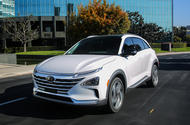Hyundai has revealed more information about the Nexo fuel cell car shown at CES earlier in the month
Hyundai’s hydrogen-powered SUV is on sale now priced from £65,995 after the government grant
Hyundai has released UK pricing and spec details of its new Nexo fuel cell SUV, which is available to order now.
The Toyota Mirai rival has a near-identical price to its Japanese competitor, hitting the market at £65,995 after the government grant. Standard kit includes sat-nav, heated and cooled electric front seats, heated rear seats, 19-inch alloys and door mirror mounted cameras to display blind spots.
The FCEV is based on Hyundai’s new FUV (future utility vehicle) platform and represents a step up in technical sophistication from the previous ix35, as well as a clean-sheet design, both inside and out. Fuel cell system efficiency has been improved and now stands at 60%, which Hyundai claims is the best ever achieved for a fuel cell vehicle. Fuel cells don’t burn hydrogen but split the molecules to produce electricity with only water and heat as by-products. The system incorporates a small lithium ion buffer battery to provide the fast response needed for acceleration.
Hydrogen capacity has been upped from 144 to 156 litres and the compressed gas is now stored at 700 bar in three tanks rather than two, one behind the right-hand rear wheel and the other two beneath the floor. The distribution and size of the tanks frees up space inside the car and there’s a generous flat-floor load space. The range has increased from 369 miles to 497 miles on the NEDC cycle and this is partly due to the increased efficiency of the fuel cell system as well as the extra fuel. Fuel consumption (of hydrogen) is 72mpg and the Nexo can be started in temperatures as low as -30deg C.
Instruments are displayed on a 7in screen with a central 12.3in screen for navigation and system information including fuel cell and storage information. The floating centre console is based on an array of conventional buttons rather than following the largely screen-based ‘glass cockpit’ philosophy. Buttons are of different sizes and shapes, which should make them easy enough to locate by touch when on the move.
European head of eco car and mobility, Frank Meijer, won’t be drawn on how quickly he expects the market for hydrogen fuel cell vehicles to develop. “Public awareness of hydrogen is not there yet,” he said, but hopes trials of fuel cell cars will help accelerate the process. Seventy-five ix35 taxis are being run in Paris and 50 in Munich. “These projects are allowing thousands of people to experience fuel cell cars first hand,” he added.
Hyundai ix35 Fuel Cell long-term test review: refuelling is child’s play
Hydrogen filling stations are still scarce with the number rising to only 14 in the UK by the middle of this year. Meijer doesn’t believe governments will fund the hydrogen infrastructure but will be prepared to continue supporting the purchase of fuel cell vehicles through grant schemes.
Manufacturing fuel cell cars remains an expensive business but Meijer hopes costs will come down as the company continues to develop electrified cars and the components are used across different platforms. Hyundai sold 501 ix35 fuel cell cars in 15 European countries and has a network of 52 dealerships.
Read more
Hydrogen cars to cost the same as hybrids by 2025, say Toyota
Hyundai ix35 Fuel Cell long-term test: an attention-grabbing eco car
Source: Autocar
